Primary Health Care for Indigenous Populations: A Needs Assessment
VerifiedAdded on 2023/06/03
|10
|2787
|54
Report
AI Summary
This report provides a comprehensive needs assessment of primary health care for Indigenous populations, focusing on the suburban Melbourne area. It highlights poorer health outcomes compared to the metropolitan counterparts, attributing this to factors like geographic isolation, resource distribution issues, and healthcare practitioner shortages. The report assesses different types of needs, including normative, felt, expressed, and comparative needs, identifying barriers such as cultural gaps and individual biases. A SWOT analysis of the healthcare setting is presented, along with program priorities, including transport arrangements, social media campaigning, and enhanced communication skills. The study concludes by emphasizing the importance of addressing these issues to improve health outcomes and ensure equitable access to primary health care services for Indigenous communities.

Running head: PRIMARY HEALTH CARE FOR INDIGENOUS POPULATIONS
PRIMARY HEALTH CARE FOR INDIGENOUS POPULATIONS
Name of the Student:
Name of the University:
Author note:
PRIMARY HEALTH CARE FOR INDIGENOUS POPULATIONS
Name of the Student:
Name of the University:
Author note:
Paraphrase This Document
Need a fresh take? Get an instant paraphrase of this document with our AI Paraphraser

1PRIMARY HEALTH CARE FOR INDIGENOUS POPULATIONS
Introduction:
The indigenous population, especially in the suburban part of Melbourne, have poorer
health outcome compared to the counterpart of the metropolitan part of the country (Lloyd,
2015). The experience of being isolated from rest another counterpart of the country
malfunctioned distributions of health resources, shortage of the healthcare practitioners and lack
of access to the primary care setting has caused the inequality of the health status which includes
social, psychological, emotional and physical and mental wellbeing (Azzopardi et al., 2015).
Primary health care proved to be effective in curing the health crisis of the indigenous
population. However, there are certain flaws in the primary health care setting that hinders the
improvement of health status of the indigenous population. Therefore, this paper will illustrate
the assessment of different needs of the population, potential challenges for need assessment and
address of them, a SWOT analysis of the healthcare setting, a program for priorities in following
paragraphs.
Need assessment of indigenous population:
A need assessment is systematic processes, which address the needs or gaps between the
current condition and desired condition, and it is a part of the planning process often used for the
improvement of communities or individual (Patton, 2018). Wakerman et al. (2017), Summarized
six types of needs which are based on Bradshaw’s and Mager. According to Chamberlain et al.,
(2016), normative needs which emerges when n individual group of people failed to meet few
established standard. The normative needs can be assessed based on primary sources. The need
can be assessed by taking into consideration the reports of the primary health care organization
and personal interviews of the individual which suggested that the lack of the access to the
Introduction:
The indigenous population, especially in the suburban part of Melbourne, have poorer
health outcome compared to the counterpart of the metropolitan part of the country (Lloyd,
2015). The experience of being isolated from rest another counterpart of the country
malfunctioned distributions of health resources, shortage of the healthcare practitioners and lack
of access to the primary care setting has caused the inequality of the health status which includes
social, psychological, emotional and physical and mental wellbeing (Azzopardi et al., 2015).
Primary health care proved to be effective in curing the health crisis of the indigenous
population. However, there are certain flaws in the primary health care setting that hinders the
improvement of health status of the indigenous population. Therefore, this paper will illustrate
the assessment of different needs of the population, potential challenges for need assessment and
address of them, a SWOT analysis of the healthcare setting, a program for priorities in following
paragraphs.
Need assessment of indigenous population:
A need assessment is systematic processes, which address the needs or gaps between the
current condition and desired condition, and it is a part of the planning process often used for the
improvement of communities or individual (Patton, 2018). Wakerman et al. (2017), Summarized
six types of needs which are based on Bradshaw’s and Mager. According to Chamberlain et al.,
(2016), normative needs which emerges when n individual group of people failed to meet few
established standard. The normative needs can be assessed based on primary sources. The need
can be assessed by taking into consideration the reports of the primary health care organization
and personal interviews of the individual which suggested that the lack of the access to the
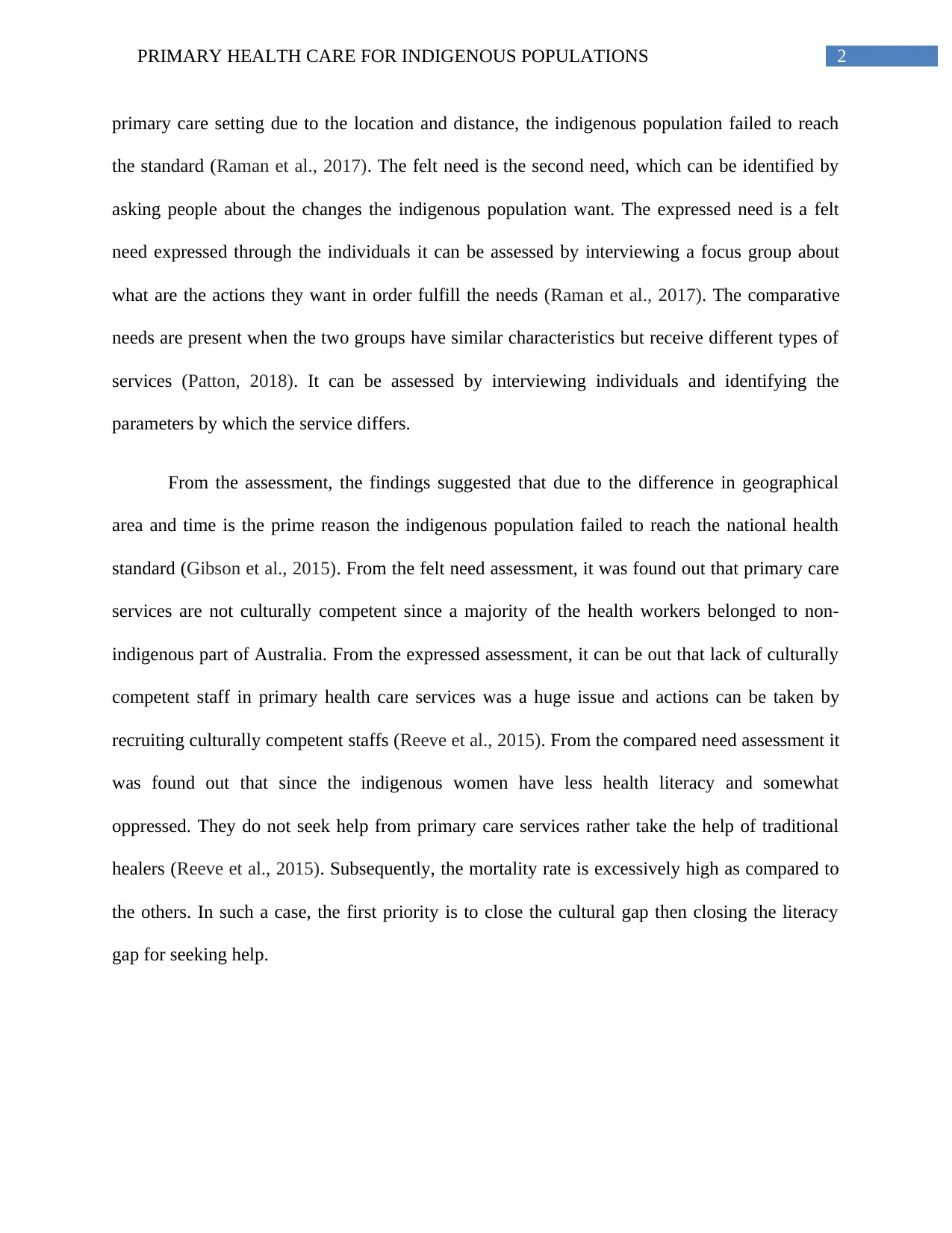
2PRIMARY HEALTH CARE FOR INDIGENOUS POPULATIONS
primary care setting due to the location and distance, the indigenous population failed to reach
the standard (Raman et al., 2017). The felt need is the second need, which can be identified by
asking people about the changes the indigenous population want. The expressed need is a felt
need expressed through the individuals it can be assessed by interviewing a focus group about
what are the actions they want in order fulfill the needs (Raman et al., 2017). The comparative
needs are present when the two groups have similar characteristics but receive different types of
services (Patton, 2018). It can be assessed by interviewing individuals and identifying the
parameters by which the service differs.
From the assessment, the findings suggested that due to the difference in geographical
area and time is the prime reason the indigenous population failed to reach the national health
standard (Gibson et al., 2015). From the felt need assessment, it was found out that primary care
services are not culturally competent since a majority of the health workers belonged to non-
indigenous part of Australia. From the expressed assessment, it can be out that lack of culturally
competent staff in primary health care services was a huge issue and actions can be taken by
recruiting culturally competent staffs (Reeve et al., 2015). From the compared need assessment it
was found out that since the indigenous women have less health literacy and somewhat
oppressed. They do not seek help from primary care services rather take the help of traditional
healers (Reeve et al., 2015). Subsequently, the mortality rate is excessively high as compared to
the others. In such a case, the first priority is to close the cultural gap then closing the literacy
gap for seeking help.
primary care setting due to the location and distance, the indigenous population failed to reach
the standard (Raman et al., 2017). The felt need is the second need, which can be identified by
asking people about the changes the indigenous population want. The expressed need is a felt
need expressed through the individuals it can be assessed by interviewing a focus group about
what are the actions they want in order fulfill the needs (Raman et al., 2017). The comparative
needs are present when the two groups have similar characteristics but receive different types of
services (Patton, 2018). It can be assessed by interviewing individuals and identifying the
parameters by which the service differs.
From the assessment, the findings suggested that due to the difference in geographical
area and time is the prime reason the indigenous population failed to reach the national health
standard (Gibson et al., 2015). From the felt need assessment, it was found out that primary care
services are not culturally competent since a majority of the health workers belonged to non-
indigenous part of Australia. From the expressed assessment, it can be out that lack of culturally
competent staff in primary health care services was a huge issue and actions can be taken by
recruiting culturally competent staffs (Reeve et al., 2015). From the compared need assessment it
was found out that since the indigenous women have less health literacy and somewhat
oppressed. They do not seek help from primary care services rather take the help of traditional
healers (Reeve et al., 2015). Subsequently, the mortality rate is excessively high as compared to
the others. In such a case, the first priority is to close the cultural gap then closing the literacy
gap for seeking help.
⊘ This is a preview!⊘
Do you want full access?
Subscribe today to unlock all pages.

Trusted by 1+ million students worldwide
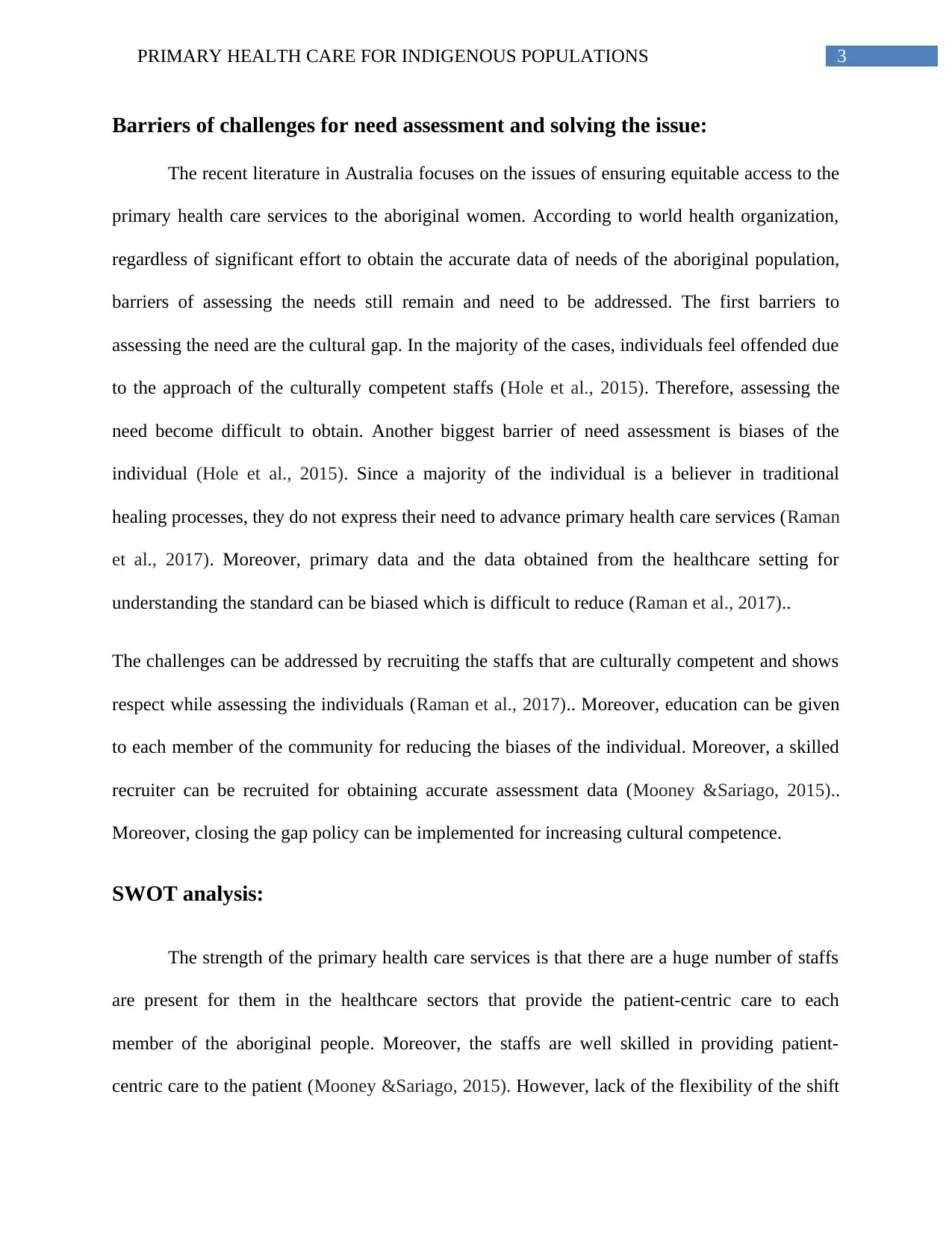
3PRIMARY HEALTH CARE FOR INDIGENOUS POPULATIONS
Barriers of challenges for need assessment and solving the issue:
The recent literature in Australia focuses on the issues of ensuring equitable access to the
primary health care services to the aboriginal women. According to world health organization,
regardless of significant effort to obtain the accurate data of needs of the aboriginal population,
barriers of assessing the needs still remain and need to be addressed. The first barriers to
assessing the need are the cultural gap. In the majority of the cases, individuals feel offended due
to the approach of the culturally competent staffs (Hole et al., 2015). Therefore, assessing the
need become difficult to obtain. Another biggest barrier of need assessment is biases of the
individual (Hole et al., 2015). Since a majority of the individual is a believer in traditional
healing processes, they do not express their need to advance primary health care services (Raman
et al., 2017). Moreover, primary data and the data obtained from the healthcare setting for
understanding the standard can be biased which is difficult to reduce (Raman et al., 2017)..
The challenges can be addressed by recruiting the staffs that are culturally competent and shows
respect while assessing the individuals (Raman et al., 2017).. Moreover, education can be given
to each member of the community for reducing the biases of the individual. Moreover, a skilled
recruiter can be recruited for obtaining accurate assessment data (Mooney &Sariago, 2015)..
Moreover, closing the gap policy can be implemented for increasing cultural competence.
SWOT analysis:
The strength of the primary health care services is that there are a huge number of staffs
are present for them in the healthcare sectors that provide the patient-centric care to each
member of the aboriginal people. Moreover, the staffs are well skilled in providing patient-
centric care to the patient (Mooney &Sariago, 2015). However, lack of the flexibility of the shift
Barriers of challenges for need assessment and solving the issue:
The recent literature in Australia focuses on the issues of ensuring equitable access to the
primary health care services to the aboriginal women. According to world health organization,
regardless of significant effort to obtain the accurate data of needs of the aboriginal population,
barriers of assessing the needs still remain and need to be addressed. The first barriers to
assessing the need are the cultural gap. In the majority of the cases, individuals feel offended due
to the approach of the culturally competent staffs (Hole et al., 2015). Therefore, assessing the
need become difficult to obtain. Another biggest barrier of need assessment is biases of the
individual (Hole et al., 2015). Since a majority of the individual is a believer in traditional
healing processes, they do not express their need to advance primary health care services (Raman
et al., 2017). Moreover, primary data and the data obtained from the healthcare setting for
understanding the standard can be biased which is difficult to reduce (Raman et al., 2017)..
The challenges can be addressed by recruiting the staffs that are culturally competent and shows
respect while assessing the individuals (Raman et al., 2017).. Moreover, education can be given
to each member of the community for reducing the biases of the individual. Moreover, a skilled
recruiter can be recruited for obtaining accurate assessment data (Mooney &Sariago, 2015)..
Moreover, closing the gap policy can be implemented for increasing cultural competence.
SWOT analysis:
The strength of the primary health care services is that there are a huge number of staffs
are present for them in the healthcare sectors that provide the patient-centric care to each
member of the aboriginal people. Moreover, the staffs are well skilled in providing patient-
centric care to the patient (Mooney &Sariago, 2015). However, lack of the flexibility of the shift
Paraphrase This Document
Need a fresh take? Get an instant paraphrase of this document with our AI Paraphraser

4PRIMARY HEALTH CARE FOR INDIGENOUS POPULATIONS
timing for the staffs in primary health care services is one of the weaknesses. Since the majority
of the healthcare sectors are far away from the populations, it is the weakness of the healthcare
sectors (Smith et al., 2016). Moreover, the lack of culturally competent workers is the weakness
of the healthcare services. Subsequently, the aboriginal patients do not seek the help of health
care services (Clark et al., 2015). Lack of knowledge and health literacy, women does not seek
the help of the health workers. Due to different geographical locations and distance , majority of
the individual in the population do not seek the primary health care services (Clark et al., 2015)..
Thus, the opportunity can be the recruitment of the culturally competent workers, even the
workers from the aboriginal population can be opportunity for providing effective primary health
care services (Clark et al., 2015). Moreover, the opportunity can be the flexible shift timing
where patients can receive effective treatment. The transport can be arranged for the individual,
who lived far away from the city in order to ensure the better health for the each member of the
community (Clark et al., 2015). The threat can be the migration of the aboriginal community due
to lack of the proper primary health care services. Moreover, threat also can be the increase of
the non adherent patient in the primary health care services due to lack of culturally competent
staffs and distance for going to the hospital (Patton, 2018)..
Program priorities
Transport: One of the key priorities of the program concerning imparting awareness of care
policies pertaining to the health of the indigenous population would be the usage of sufficient
transportation facilities of the concerned staff who would be escorted to the concerned primary
health care setting. Arranging sufficient transport facilities is of utmost importance due to the
presence of distances between the organizations providing primary health care settings and the
location of the families inhabiting indigenous populations. Hence, the program should prioritize
timing for the staffs in primary health care services is one of the weaknesses. Since the majority
of the healthcare sectors are far away from the populations, it is the weakness of the healthcare
sectors (Smith et al., 2016). Moreover, the lack of culturally competent workers is the weakness
of the healthcare services. Subsequently, the aboriginal patients do not seek the help of health
care services (Clark et al., 2015). Lack of knowledge and health literacy, women does not seek
the help of the health workers. Due to different geographical locations and distance , majority of
the individual in the population do not seek the primary health care services (Clark et al., 2015)..
Thus, the opportunity can be the recruitment of the culturally competent workers, even the
workers from the aboriginal population can be opportunity for providing effective primary health
care services (Clark et al., 2015). Moreover, the opportunity can be the flexible shift timing
where patients can receive effective treatment. The transport can be arranged for the individual,
who lived far away from the city in order to ensure the better health for the each member of the
community (Clark et al., 2015). The threat can be the migration of the aboriginal community due
to lack of the proper primary health care services. Moreover, threat also can be the increase of
the non adherent patient in the primary health care services due to lack of culturally competent
staffs and distance for going to the hospital (Patton, 2018)..
Program priorities
Transport: One of the key priorities of the program concerning imparting awareness of care
policies pertaining to the health of the indigenous population would be the usage of sufficient
transportation facilities of the concerned staff who would be escorted to the concerned primary
health care setting. Arranging sufficient transport facilities is of utmost importance due to the
presence of distances between the organizations providing primary health care settings and the
location of the families inhabiting indigenous populations. Hence, the program should prioritize
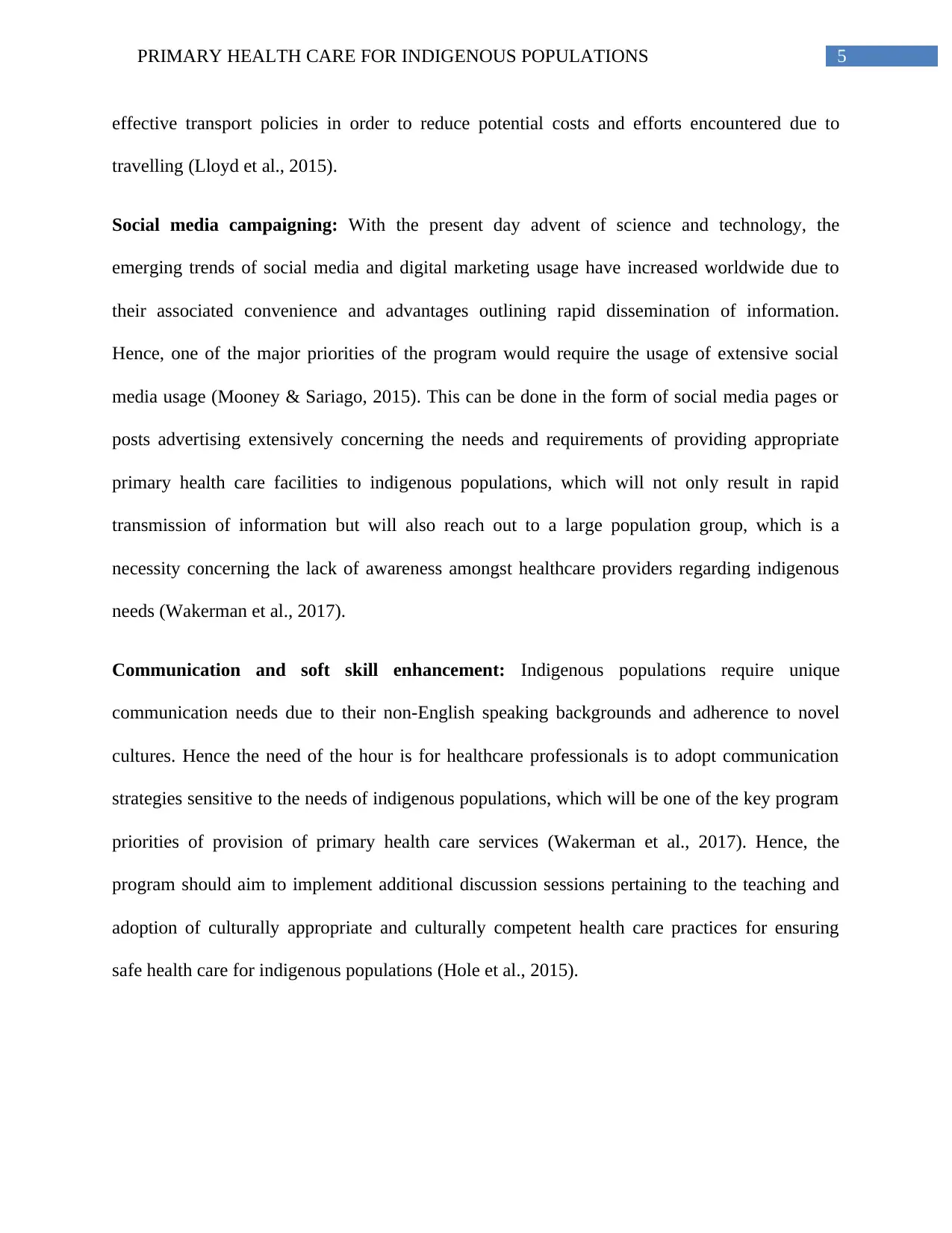
5PRIMARY HEALTH CARE FOR INDIGENOUS POPULATIONS
effective transport policies in order to reduce potential costs and efforts encountered due to
travelling (Lloyd et al., 2015).
Social media campaigning: With the present day advent of science and technology, the
emerging trends of social media and digital marketing usage have increased worldwide due to
their associated convenience and advantages outlining rapid dissemination of information.
Hence, one of the major priorities of the program would require the usage of extensive social
media usage (Mooney & Sariago, 2015). This can be done in the form of social media pages or
posts advertising extensively concerning the needs and requirements of providing appropriate
primary health care facilities to indigenous populations, which will not only result in rapid
transmission of information but will also reach out to a large population group, which is a
necessity concerning the lack of awareness amongst healthcare providers regarding indigenous
needs (Wakerman et al., 2017).
Communication and soft skill enhancement: Indigenous populations require unique
communication needs due to their non-English speaking backgrounds and adherence to novel
cultures. Hence the need of the hour is for healthcare professionals is to adopt communication
strategies sensitive to the needs of indigenous populations, which will be one of the key program
priorities of provision of primary health care services (Wakerman et al., 2017). Hence, the
program should aim to implement additional discussion sessions pertaining to the teaching and
adoption of culturally appropriate and culturally competent health care practices for ensuring
safe health care for indigenous populations (Hole et al., 2015).
effective transport policies in order to reduce potential costs and efforts encountered due to
travelling (Lloyd et al., 2015).
Social media campaigning: With the present day advent of science and technology, the
emerging trends of social media and digital marketing usage have increased worldwide due to
their associated convenience and advantages outlining rapid dissemination of information.
Hence, one of the major priorities of the program would require the usage of extensive social
media usage (Mooney & Sariago, 2015). This can be done in the form of social media pages or
posts advertising extensively concerning the needs and requirements of providing appropriate
primary health care facilities to indigenous populations, which will not only result in rapid
transmission of information but will also reach out to a large population group, which is a
necessity concerning the lack of awareness amongst healthcare providers regarding indigenous
needs (Wakerman et al., 2017).
Communication and soft skill enhancement: Indigenous populations require unique
communication needs due to their non-English speaking backgrounds and adherence to novel
cultures. Hence the need of the hour is for healthcare professionals is to adopt communication
strategies sensitive to the needs of indigenous populations, which will be one of the key program
priorities of provision of primary health care services (Wakerman et al., 2017). Hence, the
program should aim to implement additional discussion sessions pertaining to the teaching and
adoption of culturally appropriate and culturally competent health care practices for ensuring
safe health care for indigenous populations (Hole et al., 2015).
⊘ This is a preview!⊘
Do you want full access?
Subscribe today to unlock all pages.

Trusted by 1+ million students worldwide
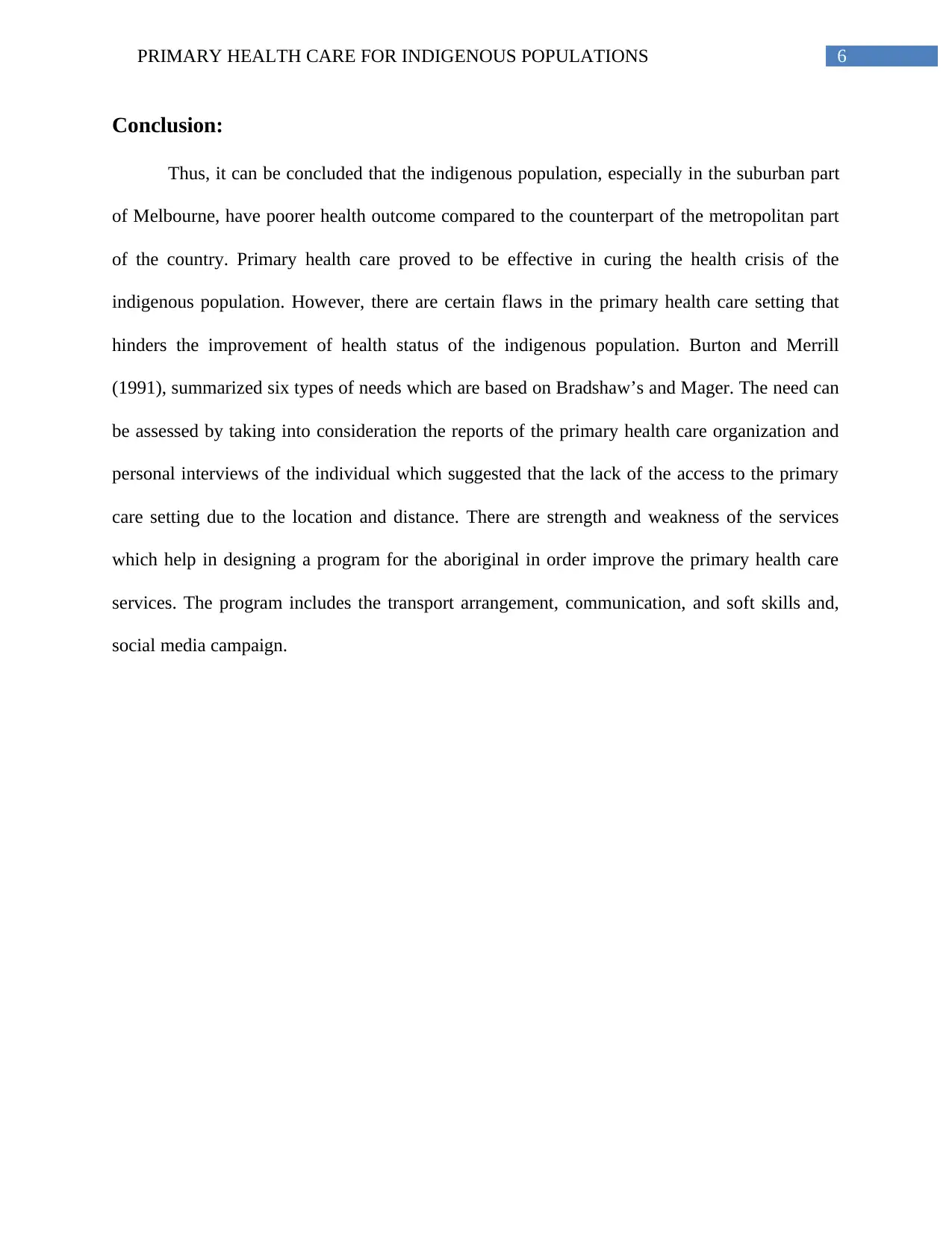
6PRIMARY HEALTH CARE FOR INDIGENOUS POPULATIONS
Conclusion:
Thus, it can be concluded that the indigenous population, especially in the suburban part
of Melbourne, have poorer health outcome compared to the counterpart of the metropolitan part
of the country. Primary health care proved to be effective in curing the health crisis of the
indigenous population. However, there are certain flaws in the primary health care setting that
hinders the improvement of health status of the indigenous population. Burton and Merrill
(1991), summarized six types of needs which are based on Bradshaw’s and Mager. The need can
be assessed by taking into consideration the reports of the primary health care organization and
personal interviews of the individual which suggested that the lack of the access to the primary
care setting due to the location and distance. There are strength and weakness of the services
which help in designing a program for the aboriginal in order improve the primary health care
services. The program includes the transport arrangement, communication, and soft skills and,
social media campaign.
Conclusion:
Thus, it can be concluded that the indigenous population, especially in the suburban part
of Melbourne, have poorer health outcome compared to the counterpart of the metropolitan part
of the country. Primary health care proved to be effective in curing the health crisis of the
indigenous population. However, there are certain flaws in the primary health care setting that
hinders the improvement of health status of the indigenous population. Burton and Merrill
(1991), summarized six types of needs which are based on Bradshaw’s and Mager. The need can
be assessed by taking into consideration the reports of the primary health care organization and
personal interviews of the individual which suggested that the lack of the access to the primary
care setting due to the location and distance. There are strength and weakness of the services
which help in designing a program for the aboriginal in order improve the primary health care
services. The program includes the transport arrangement, communication, and soft skills and,
social media campaign.
Paraphrase This Document
Need a fresh take? Get an instant paraphrase of this document with our AI Paraphraser
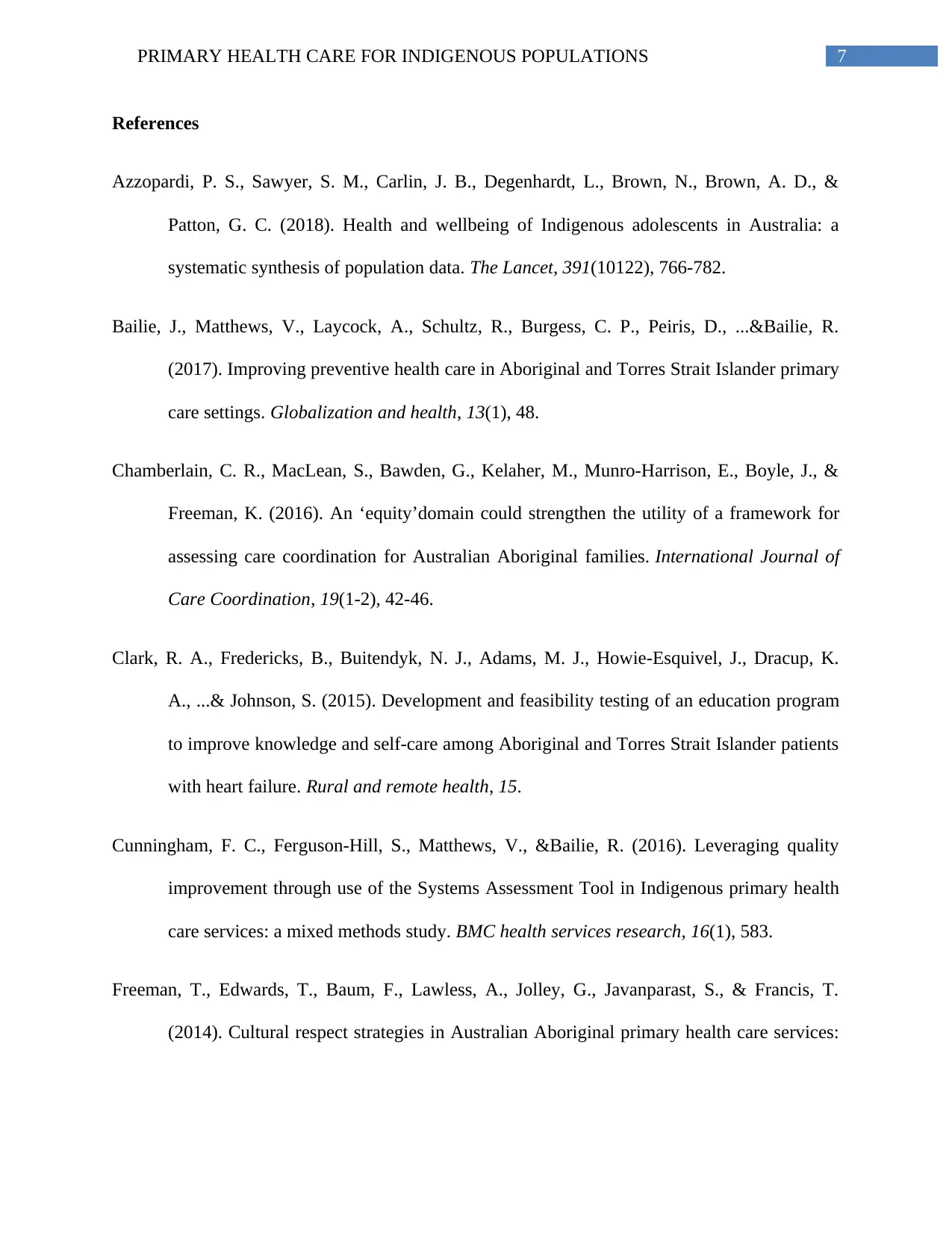
7PRIMARY HEALTH CARE FOR INDIGENOUS POPULATIONS
References
Azzopardi, P. S., Sawyer, S. M., Carlin, J. B., Degenhardt, L., Brown, N., Brown, A. D., &
Patton, G. C. (2018). Health and wellbeing of Indigenous adolescents in Australia: a
systematic synthesis of population data. The Lancet, 391(10122), 766-782.
Bailie, J., Matthews, V., Laycock, A., Schultz, R., Burgess, C. P., Peiris, D., ...&Bailie, R.
(2017). Improving preventive health care in Aboriginal and Torres Strait Islander primary
care settings. Globalization and health, 13(1), 48.
Chamberlain, C. R., MacLean, S., Bawden, G., Kelaher, M., Munro-Harrison, E., Boyle, J., &
Freeman, K. (2016). An ‘equity’domain could strengthen the utility of a framework for
assessing care coordination for Australian Aboriginal families. International Journal of
Care Coordination, 19(1-2), 42-46.
Clark, R. A., Fredericks, B., Buitendyk, N. J., Adams, M. J., Howie-Esquivel, J., Dracup, K.
A., ...& Johnson, S. (2015). Development and feasibility testing of an education program
to improve knowledge and self-care among Aboriginal and Torres Strait Islander patients
with heart failure. Rural and remote health, 15.
Cunningham, F. C., Ferguson-Hill, S., Matthews, V., &Bailie, R. (2016). Leveraging quality
improvement through use of the Systems Assessment Tool in Indigenous primary health
care services: a mixed methods study. BMC health services research, 16(1), 583.
Freeman, T., Edwards, T., Baum, F., Lawless, A., Jolley, G., Javanparast, S., & Francis, T.
(2014). Cultural respect strategies in Australian Aboriginal primary health care services:
References
Azzopardi, P. S., Sawyer, S. M., Carlin, J. B., Degenhardt, L., Brown, N., Brown, A. D., &
Patton, G. C. (2018). Health and wellbeing of Indigenous adolescents in Australia: a
systematic synthesis of population data. The Lancet, 391(10122), 766-782.
Bailie, J., Matthews, V., Laycock, A., Schultz, R., Burgess, C. P., Peiris, D., ...&Bailie, R.
(2017). Improving preventive health care in Aboriginal and Torres Strait Islander primary
care settings. Globalization and health, 13(1), 48.
Chamberlain, C. R., MacLean, S., Bawden, G., Kelaher, M., Munro-Harrison, E., Boyle, J., &
Freeman, K. (2016). An ‘equity’domain could strengthen the utility of a framework for
assessing care coordination for Australian Aboriginal families. International Journal of
Care Coordination, 19(1-2), 42-46.
Clark, R. A., Fredericks, B., Buitendyk, N. J., Adams, M. J., Howie-Esquivel, J., Dracup, K.
A., ...& Johnson, S. (2015). Development and feasibility testing of an education program
to improve knowledge and self-care among Aboriginal and Torres Strait Islander patients
with heart failure. Rural and remote health, 15.
Cunningham, F. C., Ferguson-Hill, S., Matthews, V., &Bailie, R. (2016). Leveraging quality
improvement through use of the Systems Assessment Tool in Indigenous primary health
care services: a mixed methods study. BMC health services research, 16(1), 583.
Freeman, T., Edwards, T., Baum, F., Lawless, A., Jolley, G., Javanparast, S., & Francis, T.
(2014). Cultural respect strategies in Australian Aboriginal primary health care services:

8PRIMARY HEALTH CARE FOR INDIGENOUS POPULATIONS
beyond education and training of practitioners. Australian and New Zealand Journal of
Public Health, 38(4), 355-361.
Gibson, O., Lisy, K., Davy, C., Aromataris, E., Kite, E., Lockwood, C., ...& Brown, A. (2015).
Enablers and barriers to the implementation of primary health care interventions for
Indigenous people with chronic diseases: a systematic review. Implementation
Science, 10(1), 71.
Hole, R. D., Evans, M., Berg, L. D., Bottorff, J. L., Dingwall, C., Alexis, C., ...& Smith, M. L.
(2015). Visibility and voice: Aboriginal people experience culturally safe and unsafe
health care. Qualitative health research, 25(12), 1662-1674.
Lloyd, J. E., Delaney-Thiele, D., Abbott, P., Baldry, E., McEntyre, E., Reath, J., ...& Harris, M.
F. (2015). The role of primary health care services to better meet the needs of Aboriginal
Australians transitioning from prison to the community. BMC family practice, 16(1), 86.
Mooney, B., & Sariago, P. (2015). 2Spirits: Providing a multi-generational, culturally competent
approach to health promotion for Aboriginal and Torres Strait Islander communities. HIV
Australia, 13(3), 34.
Raman, S., Ruston, S., Irwin, S., Tran, P., Hotton, P., & Thorne, S. (2017). Taking culture
seriously: Can we improve the developmental health and well‐being of Australian
Aboriginal children in out‐of‐home care?. Child: care, health and development, 43(6),
899-905.
Reeve, C., Humphreys, J., Wakerman, J., Carroll, V., Carter, M., O’Brien, T., ...& Smith, B.
(2015). Community participation in health service reform: the development of an
beyond education and training of practitioners. Australian and New Zealand Journal of
Public Health, 38(4), 355-361.
Gibson, O., Lisy, K., Davy, C., Aromataris, E., Kite, E., Lockwood, C., ...& Brown, A. (2015).
Enablers and barriers to the implementation of primary health care interventions for
Indigenous people with chronic diseases: a systematic review. Implementation
Science, 10(1), 71.
Hole, R. D., Evans, M., Berg, L. D., Bottorff, J. L., Dingwall, C., Alexis, C., ...& Smith, M. L.
(2015). Visibility and voice: Aboriginal people experience culturally safe and unsafe
health care. Qualitative health research, 25(12), 1662-1674.
Lloyd, J. E., Delaney-Thiele, D., Abbott, P., Baldry, E., McEntyre, E., Reath, J., ...& Harris, M.
F. (2015). The role of primary health care services to better meet the needs of Aboriginal
Australians transitioning from prison to the community. BMC family practice, 16(1), 86.
Mooney, B., & Sariago, P. (2015). 2Spirits: Providing a multi-generational, culturally competent
approach to health promotion for Aboriginal and Torres Strait Islander communities. HIV
Australia, 13(3), 34.
Raman, S., Ruston, S., Irwin, S., Tran, P., Hotton, P., & Thorne, S. (2017). Taking culture
seriously: Can we improve the developmental health and well‐being of Australian
Aboriginal children in out‐of‐home care?. Child: care, health and development, 43(6),
899-905.
Reeve, C., Humphreys, J., Wakerman, J., Carroll, V., Carter, M., O’Brien, T., ...& Smith, B.
(2015). Community participation in health service reform: the development of an
⊘ This is a preview!⊘
Do you want full access?
Subscribe today to unlock all pages.

Trusted by 1+ million students worldwide
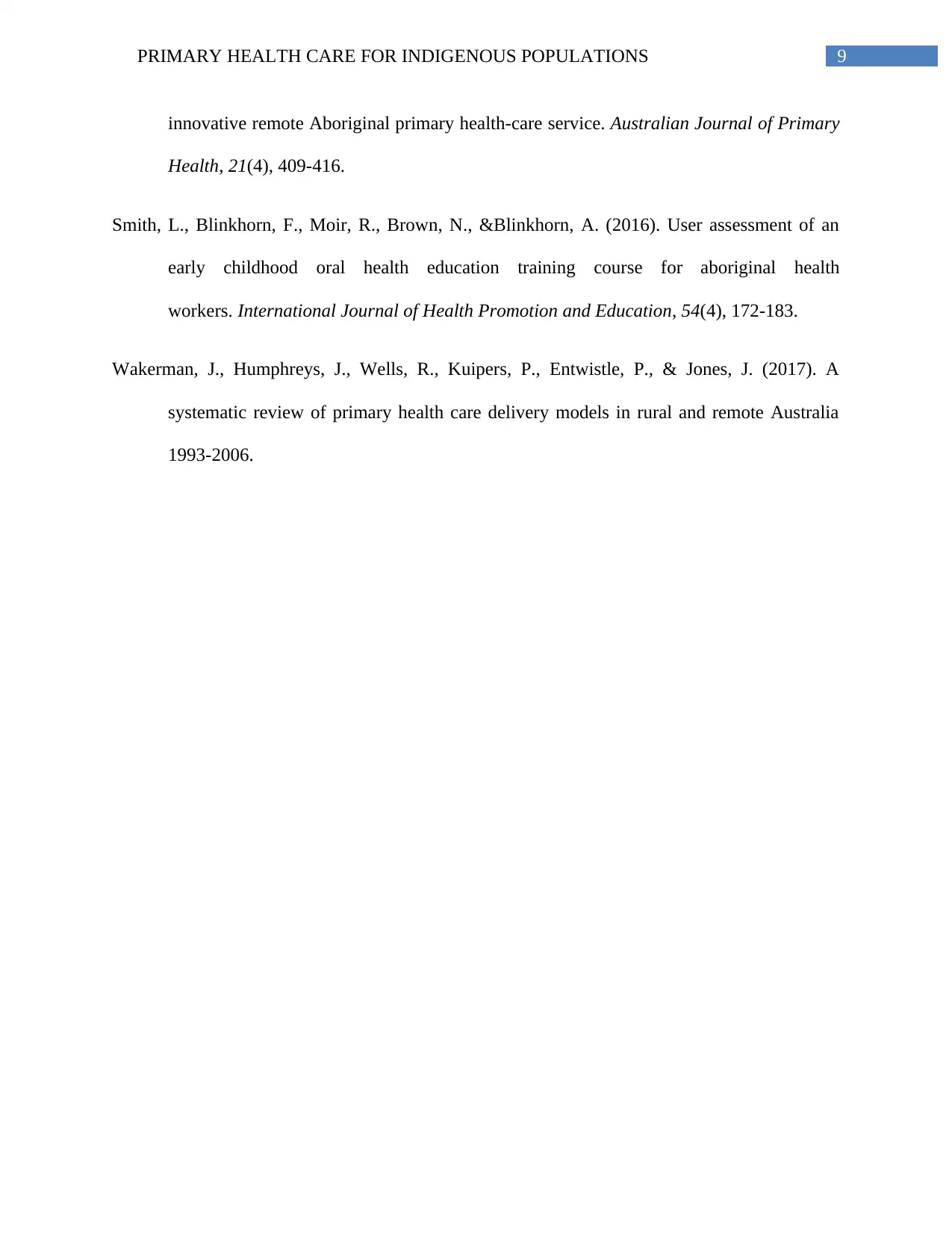
9PRIMARY HEALTH CARE FOR INDIGENOUS POPULATIONS
innovative remote Aboriginal primary health-care service. Australian Journal of Primary
Health, 21(4), 409-416.
Smith, L., Blinkhorn, F., Moir, R., Brown, N., &Blinkhorn, A. (2016). User assessment of an
early childhood oral health education training course for aboriginal health
workers. International Journal of Health Promotion and Education, 54(4), 172-183.
Wakerman, J., Humphreys, J., Wells, R., Kuipers, P., Entwistle, P., & Jones, J. (2017). A
systematic review of primary health care delivery models in rural and remote Australia
1993-2006.
innovative remote Aboriginal primary health-care service. Australian Journal of Primary
Health, 21(4), 409-416.
Smith, L., Blinkhorn, F., Moir, R., Brown, N., &Blinkhorn, A. (2016). User assessment of an
early childhood oral health education training course for aboriginal health
workers. International Journal of Health Promotion and Education, 54(4), 172-183.
Wakerman, J., Humphreys, J., Wells, R., Kuipers, P., Entwistle, P., & Jones, J. (2017). A
systematic review of primary health care delivery models in rural and remote Australia
1993-2006.
1 out of 10
Related Documents
Your All-in-One AI-Powered Toolkit for Academic Success.
+13062052269
info@desklib.com
Available 24*7 on WhatsApp / Email
![[object Object]](/_next/static/media/star-bottom.7253800d.svg)
Unlock your academic potential
Copyright © 2020–2025 A2Z Services. All Rights Reserved. Developed and managed by ZUCOL.





